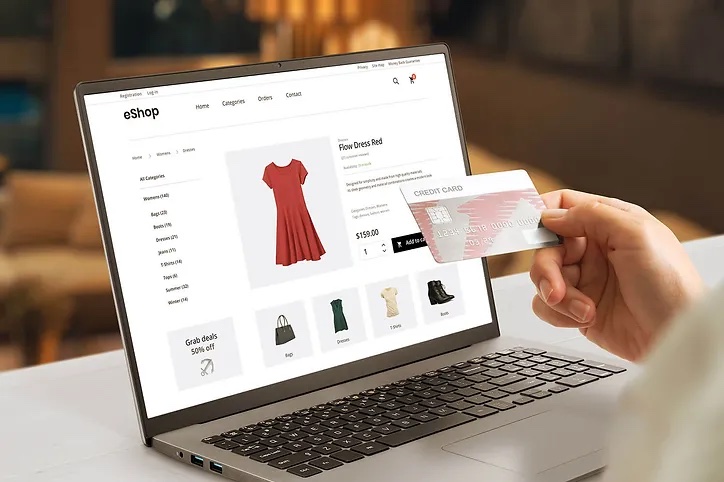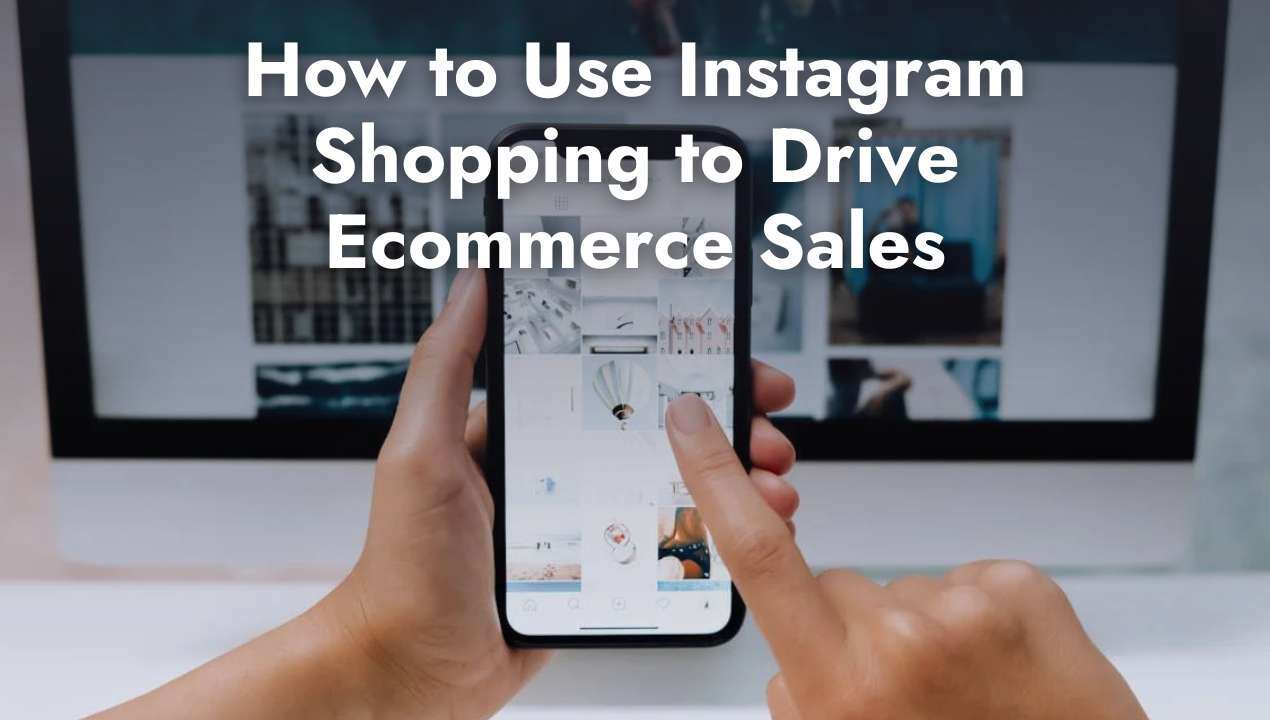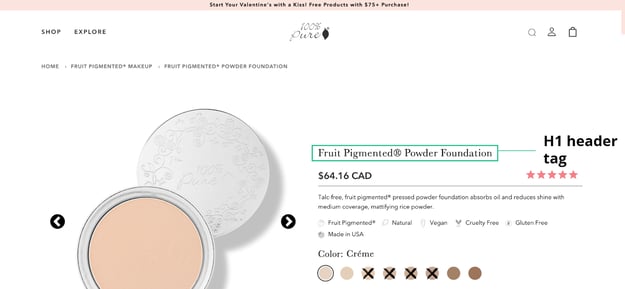Share this
Product SEO: Best Practices for Ecommerce
by Rin Mosher on Feb. 28, 2024

Are the product pages on your ecommerce website crafted with search engine optimization (SEO) in mind? If not, they might not be reaching their full potential. Acting as the virtual salespeople of an online store, product pages are only able to do their job when they're in front of customers. Optimizing your product pages plays a big role in this by influencing how discoverable individual pages are in Search Engine Results Pages (SERPs). Fully optimizing your pages with product SEO best practices will not only make it easier for customers to discover what you have to offer but also show the value of your products and compel them to buy.
Covering everything from product descriptions to structured data, this article will review tips you can use to enhance your product pages for SERP ranking and conversion rate success in 2024. Plus, we have a free downloadable product page SEO checklist that offers all our best tips and tricks at a glance.
What Makes a Good Product Page?
The product page shown below is a five-star example of what brands should do when trying to improve their product SEO and discoverability. The cosmetics brand 100% Pure has an ecommerce store laid out in a way that makes sense to search engines while remaining appealing to everyday shoppers. Although the company offers a variety of natural cosmetics, everything from foundation to moisturizer follows the same best practices – which can be applied to any industry’s product SEO.
A quick scan of the page reveals several key elements that contribute to its success:
- Strong use of relevant, product-specific keywords
- Well-structured headings and body text
- Clean and professional images
- Clear and concise product descriptions
- User-friendly navigation and layout
But there's more than meets the eye. Below, we dive deeper into the core elements of product page SEO and explain how you can incorporate them into your own ecommerce site.
Mastering Keywords for Product SEO
SEO keywords are specific words or phrases that are strategically used in online content to improve a website’s discoverability on search engines. Platforms like Google index search results based on relevancy, and keywords tell web crawlers what pages are about so they can be served to the right audiences. It’s important to use keywords so that when customers search for something specific - like “pressed powder foundation” in the 100% Pure example - that product shows up in the search results.
Keyword Research for Product SEO
Keyword research tools like Yoast, SEMRush, and Google Keyword Explorer pull back the curtain on what phrases and terms people are searching for when it comes to the products your business sells. You can use these tools to identify potential keywords for products, ideally targeting terms that have high search volume, low competition, and are in line with the right intent.
Different variations of the same terms and phrases receive varying levels of search volume, so the specific ones you choose to use on a product page can have a big impact on SERP performance.
For example, broader keywords like “makeup” receive a large amount of volume because they’re extremely general. Someone who types “makeup” into a search engine might be looking to buy products, but it’s just as likely that they’re looking for definitions or makeup inspiration - which probably isn’t the type of traffic you want to capture. Meanwhile, specific search terms such as “powder foundation” may get less volume by comparison but, by being more specific, are better for reaching the right audience.
Creating Compelling Product Descriptions
The description section is the first place on a page people turn to for details on things like features and how to use the product. It’s your opportunity to encourage conversions by addressing potential buyers’ questions head-on, as well as a massive determinant of SEO success.
Strong descriptions make as strong of a case for why a reader should buy a product as possible. The more compelling points a product description makes, the more likely users are to take action after clicking a product page, and the more valuable it is to be seen by Google.
Product descriptions don’t need to be long in order to be effective; while more than 87% of online shoppers place a high value on product descriptions, only 13% read them word for word. The rest scan content to pluck out the specific information they’re looking for, which is harder to do with longer paragraphs. It’s best to structure information in order of importance so people see it faster. Keywords can help call their attention to key points while further supporting SEO.
By making every description concise and easy to read, you also reduce bounce rates by keeping users from opening another tab to search for an answer or, even worse, an alternative product. Low bounce rates have the potential to improve organic traffic even further by increasing a page’s relevancy for search engines.
100% Pure’s product description shown above does an excellent job of striking a balance between detailed and concise. It leads with a strong selling point that doubles as a descriptive keyword for its face powder, then proceeds to highlight the product’s application and benefits in the same sentence. The following portions cover ingredients in more detail while explaining how each one contributes to the formula in its own way. Key points about oil-absorbing properties and no chemical preservatives further convey the value customers receive from the product.
How to Write Product Descriptions for SEO
The key is to be detailed but concise, avoiding multiple paragraphs of text while formatting descriptions for easy readability and scannability. Google’s Merchant Center encourages ecommerce stores to write unique product descriptions that are at least 300 words in length but also to refrain from filling their pages with ‘fluff’ (useless information). Short sentences are easier for online shoppers to read and are also favored by search engine algorithms.
Keep your product SEO descriptions concise by:
- Writing in an active voice
- Removing excess adjectives
- Avoiding the use of filler words
You should also make every sentence purposeful by prioritizing key points like product size, dimensional weight, material, special features, technical specifications, shape, pattern, texture, design, or whatever is most relevant to your product and target audience. Every line should present new but relevant information. Try to include semantically keywords wherever possible to further enhance the page’s relevance.
This is done well throughout the 100% Pure product description referenced above, which contains not only the keyword “face powder” but also related terms and variations like “powder foundation” and “rice powder”. Additional keywords such as “oil-absorbing,” “mattifying,” and “ultra-light” double as selling points while adding context as to how the face powder looks and feels on the skin.
While it may be tempting to copy and paste a generic excerpt across all of your similar product listings, doing so will hurt your SEO rankings. This is because, in addition to considerations like text length and relevancy, Google also factors uniqueness into its SERP results. Duplicate content tells web crawlers that there isn’t anything particularly valuable or useful about a specific product page, causing it to become overlooked for ones that are more likely to solve a user’s query.
Specific vs. Broad Target Keywords
Because product pages focus on individual items, it makes the most sense to select narrow keywords over broad ones. Long tail keywords reflect more specific searches - not just "foundation" or “lipstick,” for example, but "natural matte women’s face foundation" or "ruby red oil-based lipstick."
Being specific in how you refer to a product on its official page will differentiate it from others while preventing keyword cannibalization, which is when items in the same general category compete against one another in SERPs. This is especially important when it comes to local SEO for small businesses; targeting precise long-tail keywords captures highly relevant traffic from consumers searching for products in a specific region or market.
Competitor Analysis
You don't need to start your keyword strategy from scratch. Many companies use SEO tools to analyze other brands' product pages for insights into the keywords they are using, their keyword density, and potential optimization opportunities they can seize.
Our in-depth analysis of best practices for product SEO continues below, and we also have a free Product SEO Checklist that lists all the tips you need at a glance to ensure every product page you have is SEO-optimized.
Download our Product SEO Checklist
Optimizing Meta Tags for Enhanced Visibility
Meta tags are snippets of text that provide information about a webpage or website. They help search engines understand what a page is about and how it should be indexed and displayed. We explain how you can optimize meta tags for search engine discoverability below.
Title Tag and Header Tags
The title tag appears in the browser tab and as the clickable link on SERPs. This is the most important meta tag, as it’s typically the first thing people read when considering what results to click on.

Header tags (H1, H2, H3, etc.), on the other hand, are used to organize and structure the content on a webpage. H1 tags are typically used for the main title of a product page, while H2 and H3 tags are used for subheadings and further organization.
How to Optimize Product Title Tags and Header Tags
Title tags and header tags should start off with the main keyword you want to target and only use that keyword once per tag. 100% Pure does this by including “powder foundation” - acting as both the keyword they want to target and the name of this particular product - in both the Title Tag and H1 Tag. Search engines give more weight to Title Tags, so it’s particularly important to keep them concise, informational, and between 30 and 60 characters.
How to Change Title Tags and Header Tags
Title tags are traditionally edited within the <head> section of the HTML code of a webpage. Platforms like Shopify for ecommerce usually offer built-in fields that make it easy to write and optimize titles without having to go in and manually edit code.
You can format header tags in markdown by adding one or more hashtags before the text. Content editing tools in ecommerce platforms also have built-in formatting options for header tags.
Meta Description
A meta description is a brief summary of a webpage's content. It appears below the title tag on SERPs and helps users decide whether or not to click through to your page. Like title tags, meta descriptions are limited in length. You have an optimal range of 70 to 155 characters to convey what the internal content is about, its relevance to a user's search, and compel action.
Meta descriptions should include at least one primary keyword and remain consistent with the points outlined in the full product description. Think of this text as a condensed but compelling summary of what readers will learn by reading the whole thing.
Meta descriptions can be directly edited in HTML or through a CMS platform's metadata settings. Include at least one main keyword in meta descriptions and make each description unique to avoid duplicate content issues.

Leveraging Images and Visuals for SEO
The benefits of good product images are multifold. From a sales perspective, strong visuals give visitors a clear idea of what they can expect to receive upon making a purchase, which then has the potential to directly impact SEO by increasing page value and engagement rates.
Best Practices for Ecommerce Product Page Images
Use the following strategies to maximize the effectiveness of your product images and, in turn, improve SEO performance:
Use Unique and High-Quality Images
First impressions count, and there’s no better way to make a good one than with high-resolution, professionally captured product images. Make sure to include photos that show different perspectives of your product, including close-ups and shots from various angles to give visitors a holistic understanding of what it looks like. This is also a great opportunity to showcase specific features up close.
Optimize Image File Names
When saving your images, use descriptive and keyword-rich file names instead of generic ones like "IMG_1234." This helps search engines better understand what the image is about and can improve your SEO ranking.
It’s best to keep file names between five and six words in length, separated by hyphens. Try to weave keywords in where possible but ultimately make sure every name fully reflects the image at hand.
In the case of 100 Percent Pure, the file names chosen could start with the product name and specify each shot as follows:
- fruit-pigmented-foundation-powder-front.jpg
- fruit-pigmented-foundation-powder-open.jpg
- fruit-pigmented-foundation-powder-up-close.jpg
Use Alt Text
Alt text, short for alternative text, is the written description of an image on a web page. It serves as a replacement for the image if it cannot be displayed, informs screen readers for the visually impaired, and also helps search engines understand what the image is about. Make sure to use descriptive and relevant alt text for all product images and include keywords whenever possible.
Alt text snippets shouldn’t start with ‘photo of’ or ‘image of,’ but rather use every one of their optimal 10 to 12 words to describe the specific product shown.
Here’s an example:
Nine gram Fruit Pigmented Foundation Powder White Peach texture close up
Optimizing Structural Elements for Product SEO
Not all aspects of SEO are obvious; beyond keywords and visuals, page structure also has a significant impact on how discoverable product pages are to search engines. Learn how you can use strategic structural changes to your advantage in SERP rankings below.
Structured Data
Structured data is a type of organized information that is formatted in a way that makes it easily understandable and machine-readable. It refers to any type of data that has been marked up or tagged with specific attributes, allowing search engines and other computer systems to better understand and interpret the content. This can improve the visibility and appearance of a website in search engine results pages (SERPs) and may even result in additional features being displayed, such as rich snippets or knowledge graphs.
Product and Review structured data, for example, makes price, availability, customer reviews, and shipping information visible in rich results, as seen below.

It's important to note that structured data is not a direct ranking factor but rather has the potential to indirectly impact rankings by improving product page visibility and click-through rates. The value of implementing this strategy will only increase as search engines continue to evolve in favor of more visual-based user experiences.
Using Structured Data to Boost Product SEO
Incorporating structured data into your ecommerce SEO strategy can be complicated, especially if you don't have a background in markup. The process involves identifying relevant data for your products and then using a specific language, such as JSON-LD or Microdata, to mark up your content.
One of the most popular tools for implementing structured data is Google's Structured Data Markup Helper. This tool allows you to select the type of data (e.g. articles, events, products) and then highlight and tag the relevant information in your content. It also generates the necessary code for you to add to your website.
Breadcrumb Navigation
Breadcrumb navigation is a secondary navigational aid that helps users track their path from the main shop page to specific products or categories. It is a visual representation of the user's location within your online store and allows them to easily navigate back and forth between pages.
The improved user experience this creates can lead to longer site visits and lower bounce rates, which are positive signals to search engines. It also creates internal linking opportunities by connecting related pages.
When you link to another page on your site, you are essentially telling search engines that this page is important and relevant enough to be connected to other pages. Breadcrumbs also serve as a form of keyword-rich anchor text, which can help boost the SEO value of your internal links.
Implementing Breadcrumb Navigation for SEO Products
Most ecommerce platforms have built-in breadcrumb navigation features that you can easily enable on your site. If your platform doesn't have this feature, there are also plugins available that can help you incorporate breadcrumb navigation into your website's design.
The most important thing to remember during the setup process is thoughtful structure. A clear hierarchical system will make it easier for both people and search engines to find specific pages.

HOME > FRUIT PIGMENTED® MAKEUP > FRUIT PIGMENTED® POWDER FOUNDATION
In the example shown above, users are presented with a clear path from the homepage to a specific product. Each part of the breadcrumb trail narrows what is shown by core differentiators like product type, application, and design.
Other breadcrumb navigation best practices to keep in mind:
- Ensure each part of the breadcrumb trail is short and concise
- Avoid the use of abbreviations and acronyms
- Keep breadcrumb titles consistent with page titles
URL Structure
Uniform Resource Locators, or URLs, are addresses used to locate specific web pages or resources on the internet. The path, also known as the slug, is the section of a URL that identifies the specific location of a resource on a server. In the context of ecommerce websites, for example, a product page URL would often include the path "/products/product-name" like so:
www.100percentpure.com/collections/face-makeup/products/fruit-pigmented-foundation-powder
URL paths have a direct connection to product SEO success. A well-structured URL can make it easier for users to navigate your site, remember a specific page's address, and for search engines to crawl and index your content.
Keywords also have the potential to influence URL SEO optimization. In our example, "fruit-pigmented-foundation-powder" might be a popular search term for people looking to purchase that specific product.
The other section, “face-makeup,” satisfies a broader umbrella term that users also type into Google for relevant searches.
How to Change Product URL Paths
Most ecommerce platforms assign products generic URL paths by default, like www.example.com/product12345. You can change these to be more descriptive and SEO-friendly by accessing your product settings or using a URL rewriting tool.
When changing the URL path for a product, it's important to make sure you set up redirects from the old URL to the new one. This ensures that any existing links or bookmarks will still lead to the correct page and prevents any loss in traffic or sales.
Incorporating FAQs for Product SEO
What you write in an FAQ section can make the difference between someone staying on your product page and going somewhere else. That’s important not only for sales but also for web metrics that impact SEO, like time on page. Long sessions on product pages tell Google that content is engaging to users, increasing the likelihood of ranking higher on the search engine results page.
Every additional line of text you create is also an opportunity to fit more relevant search terms onto a page. While product descriptions are limited by the need to be succinct, FAQ sections can accommodate several extra paragraphs of text. This makes it easy to include additional keywords without overstuffing.
If your FAQ section is optimized and structured correctly, you may have the opportunity to show up in Google's 'People Also Ask' snippet and gain more visibility on search engines that way, as well.
How to Write an FAQ Section for Product SEO
FAQ sections are most valuable to readers and therefore more valuable to search engines when they provide meaningful answers to questions people actually ask. If you aren’t sure what your customers are thinking, look back at real queries and customer support emails your brand has received in the past. Tools like SEMRush can also provide insight into what users search for by keyword.
Back to our example page, 100% Pure uses an FAQ section to address commonly asked questions about its powder foundation. These product-specific questions provide prospective customers with assurance on issues like consistency, ingredients, and coverage before they buy.
Supporting Product SEO with Page Speed
Page speed is another more technical but incredibly powerful element at play with product page SEO. Defined as the amount of time it takes a web page to load on a user's browser, this metric matters most for its connection to bounce rates. The longer someone has to wait for a page to load, the more likely they are to leave the site and look elsewhere. This can have a significant impact on SEO as search engines prioritize user experience and satisfaction in their rankings.
Page speed matters on every part of a website, but especially product pages. This is because these pages are often the final destination for potential customers who are ready to make a purchase. If the page takes too long to load, they may become frustrated and abandon their shopping journey. This not only affects sales but also sends a negative signal to search engines about the quality of the website.
Google’s PageSpeed Insights tool can tell you the exact amount of time it takes each of your product pages to load. The reports are in-depth, providing performance data for both mobile and desktop devices, as well as suggesting ways to improve page speed.
How to Improve Your Page Speed for Better SEO
One thing PageSpeed Insights will almost certainly recommend for your product page SEO is image compression. Large, high-resolution images can slow down page loading times significantly. Keeping sizes under 2 MB should help reduce latency and ensure slow-loading pictures don’t impede the user experience. You can also consider using a content delivery network (CDN) to improve loading times.
Another important factor is the use of caching. This means storing frequently accessed data, such as product information, on the user's device so that it can be quickly retrieved when needed. Caching can be implemented through various tools and plugins, depending on the platform of your website.
In addition to technical improvements, there are also design elements that can impact page speed. For example, having too many pop-ups or auto-playing videos can slow down page loading times. Simplifying the design and minimizing these elements can greatly improve page speed.
Mobile Optimization
With the increasing use of mobile devices for online shopping, it is crucial to ensure that you’ve optimized your product page for mobile users. This starts with a responsive design that adjusts to different screen sizes and orientations. Most web platforms now offer responsive design templates, but you can hire a developer to create a customized mobile version of your product page if needed.
Other best practices, like having large enough buttons and links for easy navigation and minimizing the use of large images, don't require a developer and can greatly improve mobile user experience.
SEO can seem daunting and overwhelming at first, but it's an unavoidable part of running a successful ecommerce store. Prioritizing SEO in product pages can give you a competitive edge in a landscape that's increasingly hard to stand out in. While it may take some hard work and effort to optimize your content, the long-term benefits will be worth it.
As your page visibility increases, you may also find yourself struggling to fulfill a large amount of orders. Shipfusion's third-party logistics (3PL) solutions, advanced integrations, and industry-leading support can allow you to focus on growing your business while we handle the logistics of warehousing and shipping. Contact one of our fulfillment experts to learn more about our services today.
Share this
You May Also Like
These Related Articles

Follow These Advanced Best Practices for WooCommerce Success

How to Use Instagram Shopping to Drive Ecommerce Sales

How to Sell On Facebook as a Business In 2025
- April 2025 (18)
- March 2025 (26)
- February 2025 (26)
- January 2025 (37)
- December 2024 (16)
- November 2024 (23)
- October 2024 (22)
- September 2024 (27)
- August 2024 (9)
- July 2024 (8)
- June 2024 (5)
- May 2024 (8)
- April 2024 (8)
- March 2024 (6)
- February 2024 (6)
- January 2024 (5)
- December 2023 (3)
- November 2023 (3)
- October 2023 (5)
- September 2023 (4)
- August 2023 (2)
- July 2023 (1)
- June 2023 (4)
- March 2023 (2)
- October 2022 (1)
- September 2022 (5)
- August 2022 (4)
- July 2022 (7)
- June 2022 (4)
- May 2022 (4)
- April 2022 (6)
- March 2022 (2)
- February 2022 (1)
- January 2022 (3)
- December 2021 (2)
- November 2021 (4)
- October 2021 (2)
- September 2021 (5)
- August 2021 (4)
- July 2021 (4)
- June 2021 (3)
- May 2021 (2)
- April 2021 (3)
- March 2021 (3)
- February 2021 (3)
- January 2021 (2)
- December 2020 (4)
- November 2020 (2)
- October 2020 (4)
- September 2020 (2)
- July 2020 (5)
- June 2020 (4)
- May 2020 (2)
- April 2020 (2)
- March 2020 (4)
- February 2020 (1)
- December 2019 (1)
- May 2018 (1)
- March 2018 (2)
- February 2018 (3)
- January 2018 (3)
- November 2017 (3)
- July 2017 (4)
- March 2017 (3)
- February 2017 (5)
- January 2017 (3)
- December 2016 (4)
- November 2016 (6)
- October 2016 (6)
- October 2015 (1)
- September 2015 (1)
- June 2015 (3)
- May 2015 (3)
- August 2014 (1)
- July 2014 (1)
- March 2014 (1)
- February 2014 (1)
